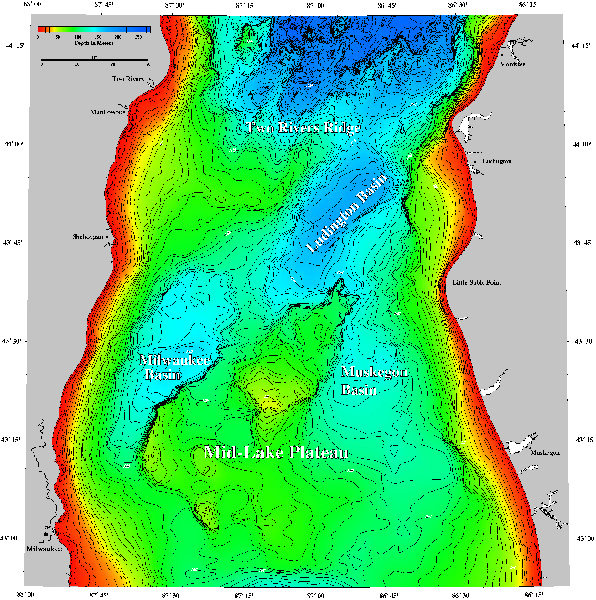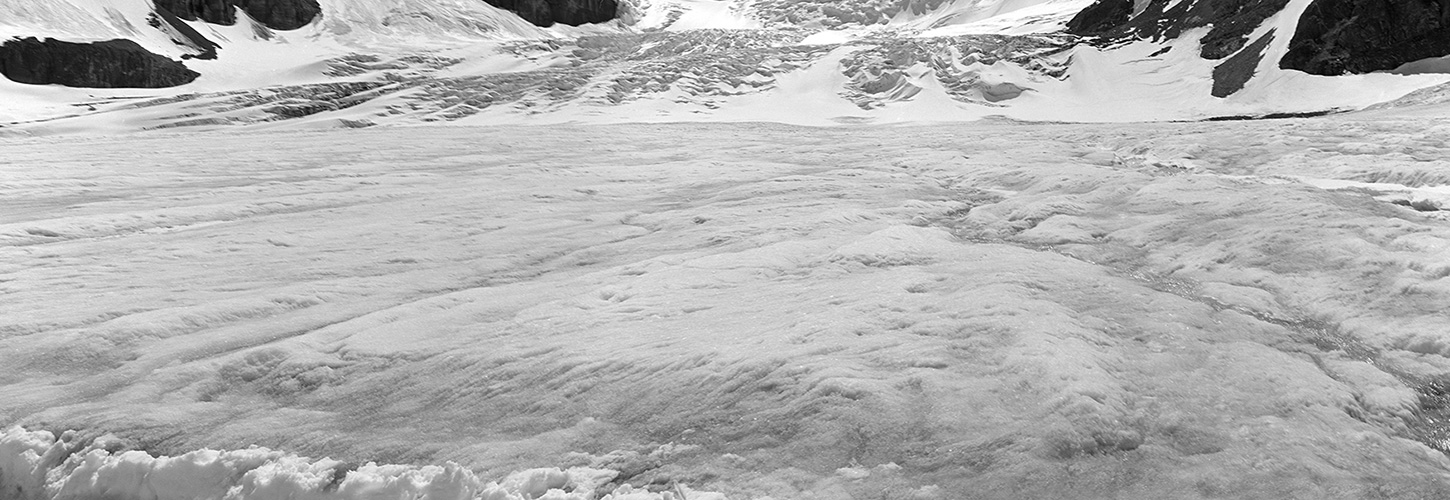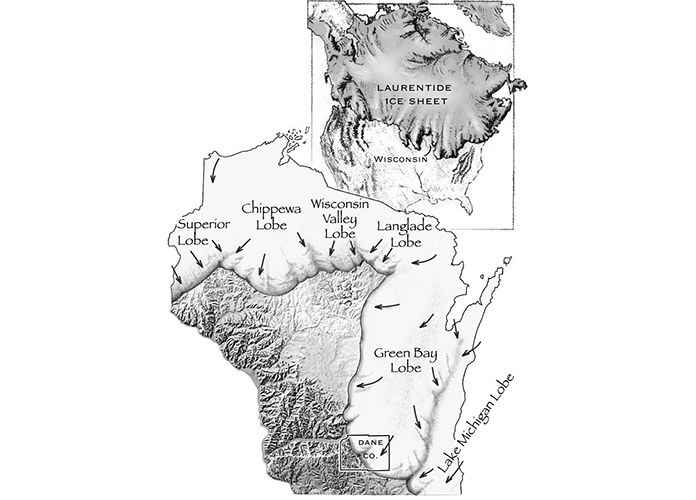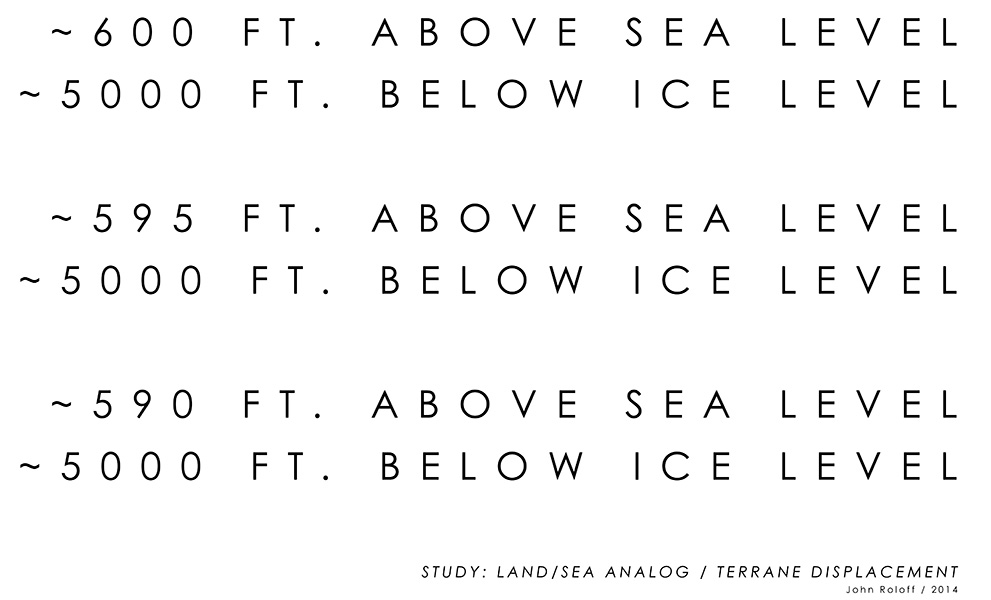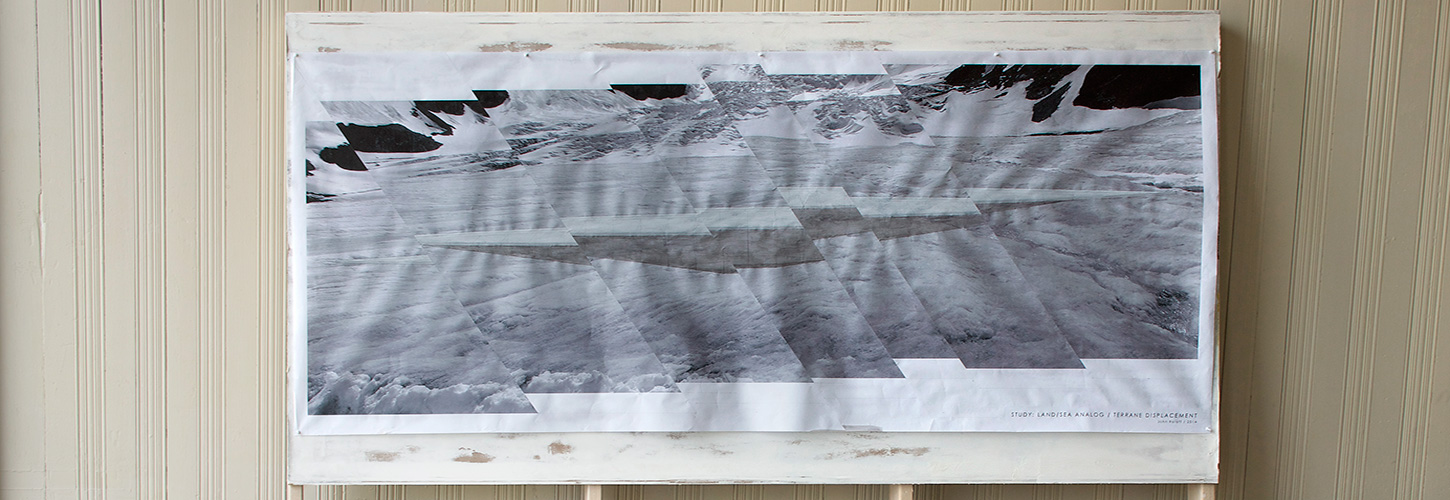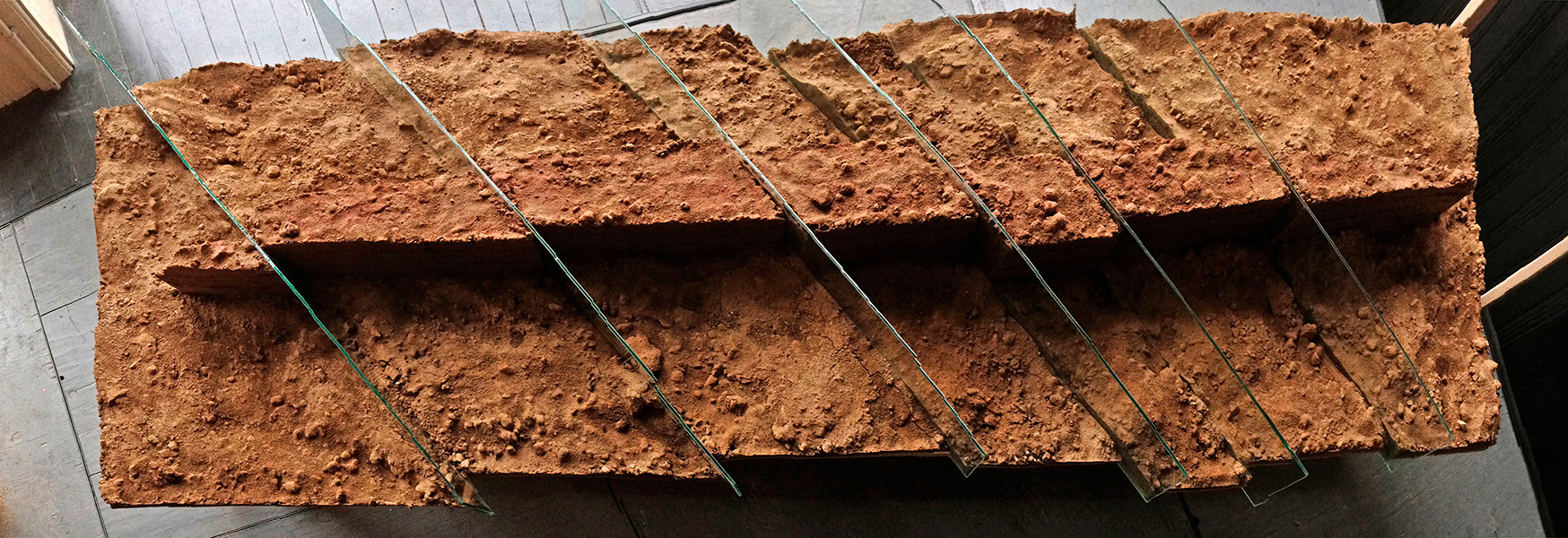Top: Mid-Lake Plateau region bathymetry / Lake Michigan / off-shore of Milwaukee / Great Lakes Data Rescue Project - Lake Michigan Bathymetry / NOAA National Ocean Service / 2012.
Bottom: Comparative text for exhibition windows / Pleistocene > Holocene altitudes of the site / distance beneath Pleistocene ice and altitude above Holocene sea levels. |
Top: Panorama of Columbia Ice Fields, Canadian Rockies, British Columbia, Canada / from excursion to the Ice Fields mid-1990's.
Bottom: Study: Land/Sea Analog / Terrane Displacement / installation detail / pencil, acrylic and inkjet on vellum on sheet rock and wood frame, 96 in. x 95 in. / 2014 |
Top: Wisconsin glaciation / Laurentide Ice Sheet / 31,500-18,000 ybp., from: Wisconsin Geological & Natural History Survey » Ice Age geology.
Bottom: Study: Land/Sea Analog / Terrane Displacement, pencil, acrylic and inkjet on vellum, sheet rock on wood, 96 in. x 95 in. / center - S. E. Wisconsin glacial till, glass, wood. 41 in. x 108 in. / windows: text strips denoting "5000 ft below ice level, inkjet on vellum / 2014. Commercial stage component created an elevated platform for the tableau works at the level of the Pritzlaff windows. |
Top: Preliminary concept for the Menomonee River, Milwaukee, WI / Sediment Ship Study / 2014. Based on projects considered for the Exploratorium, San Francisco, CA 2008-12. Aerial image by Google Earth / 2012.
Bottom: Top view of Study: Land/Sea Analog / Terrane Displacement / tableau element / S. E. Wisconsin glacial till, glass, wood. 41 in. x 108 in.
|
Land/Sea Analog / Terrain Displacement
For the installation Great Lakes with Neil Forrest
NCECA 2014 / Milwaukee, WI / Pritzlaff Building
Study: Land/Sea Analog / Terrane Displacement, and it’s companion tableau element of wood, glacial sediment and glass, investigates the Pleistocene, glacial, genesis of the the Great Lakes and related terrains/terranes globally. In Study: Land/Sea Analog / Terrane Displacement, the physically offset image of the contemporary, archetypal, Columbian Ice Fields of the Canadian Rockies is echoed in the adjacent tableau sculpture, of a ship and environment composed of S. E. Wisconsin sediment undergoing displacement by glass ‘fault’ planes. This assemblage suggests analogs to generative processes of local glacial transport and displacement as well as larger systems of land and sea evolution. Much of the area now named Wisconsin was coverd by glacial ice up to 5000 ft thick numerous times during the Pleistocene glacial period depositing glacial till and other surficial deposits. The Wisconsin terrain may be visualized as strati-chronographically generated and situated between a mile (or more) thick sea of ice, ancient hydrologic and marine environments and the contemporary oceans of some -600 ft. below datum. The Columbian Ice Fields was visited in the mid-1990's, from which the images used in the work were derived. Reportedly, the extent of the ice fields in considerably diminished since that visit. |
Great Lakes / Original Project Concept:
Study: Land/Sea Analog / Terrane Displacement was developed as a singular work for the exhition Great Lakes in tandum with a similar work by Neil Forrest on the same stage and co-designed exhibtion environment. Both of our works examine the history of what is known as the Great Lakes, born during the recent ice ages and locus of a wide range geo-materiality. As a hydrologic system, the Great Lakes, in human time, has provided a tableau for exploration, transport and climate generation, while the area bordering the Great Lakes is extraordinarily enriched zone of substance and production. The relationship of these domains have created complex and varied narratives unveiled by the artist's extensive site research into the cultural, industrial, geologic histories of Milwaukee and the SE Wisconsin terrain. The exhibition “Great Lakes” is two solo works by two artists on the same theme with different interpretations of the research and site, using similar materials on a common platform. These two clay and media assemblages each explore the unique transport/geology/mined materials (& manufactured) engendered by the Great Lakes system and its history. The exhibition considers salient aspects of Great Lakes history and Milwaukee’s context within it, using examples and analogs of glacial and lacustrine systems, trade, architectural design, transportation and prosperity that relate to the origin, conveyance and use of raw and processed materials in this region. Great Lake freighters and other historical vessels to glacial, geo-transport and ore analogs are inspirations of material transformation localizing Milwaukee within the Great Lakes, and the Great Lakes within a continental narrative of origin, transport and production.
In addition to the history of Forrest and Roloff's use of the ship image, Michel Foucault allegory of ships futher frames the exhibition's concept. The ‘endless journey’ (Foucault’s idea of the transiting ship) provides our heterotopia – an approximation of a utopia, or a parallel space, expressed through both cultural and natural systems of substance, metaphor and evolution. Additional ship and material influences include: the famous cream brick of Milwaukee, the Milwaukee Deep Tunnel System, the hydrologic system of both the Great Lakes and the Milwaukee area, the Pleistocene central NA glacial episodes and the deeper regional geologic structures. Exposures of the Maquoketa shale, Menomonee Valley clay deposits, unconsolidated river and lake sediments and transported metalliferous ores are considered as potential raw materials for site-based fabrication.
|
Other Projects by Forrest/Roloff
Perils in the Sublime / NCECA 2009 / Phoenix, AZ
Diderot/Forrest/Roloff / NCECA 20174 / Portland, OR
Return to Recent/Selected Projects Page
Return: Shear Zones: Displacements/Permutations over 40+ Years of Ceramic Practice
|
